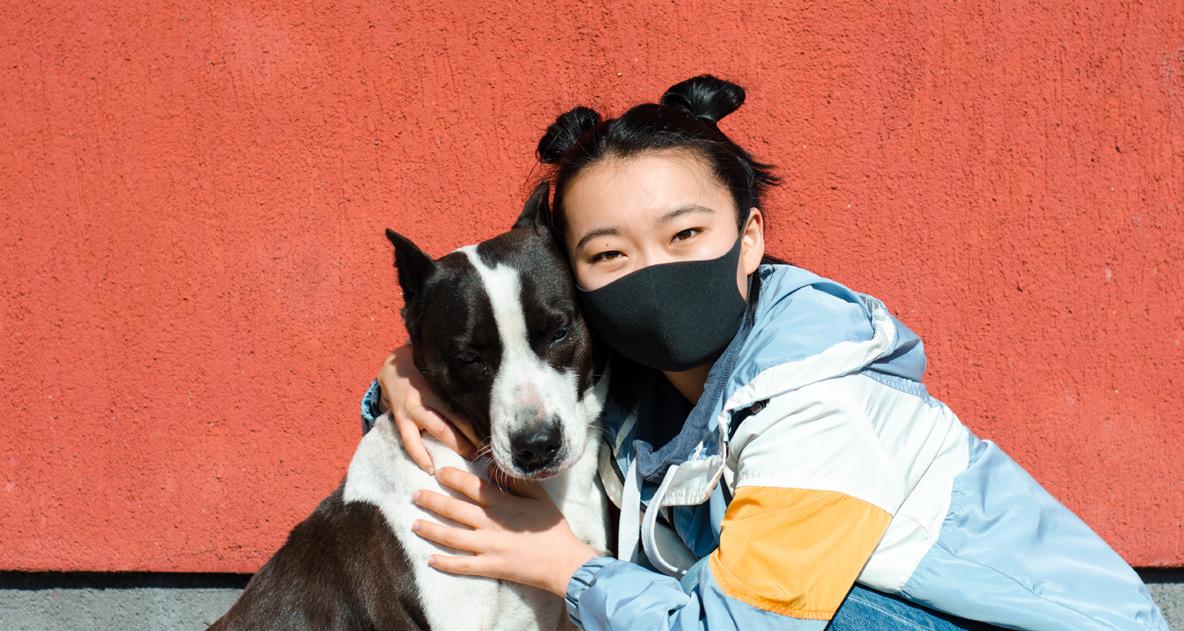Mind Matters
Please Don’t Go: How
Separation Anxiety Affects Our Pets BY TRACY WRIGHT
Pets are more than animals to us — they are family. And in 2020, we experienced a whole lot of quality family time, which included more time with our furry friends. Pets got used to having their family around…all the time! Now with many people already returning or preparing to return back to the office and school — even in a limited capacity — our pets will need to get used to us being gone after a long period of time at home. This separation can cause a great deal of distress and anxiety for pets. “During the COVID quarantine, pets generally fared better since they like having their ‘people’ around,” said Terry Tomlin, DVM, veterinarian at Town and Country Animal Hospital. “Dogs and cats crave routine, and once that routine abruptly changes, there is absolutely an increase in related anxiety.” According to VCA Animal Hospitals, the signs of pet anxiety can manifest itself in pacing, jumping, vocalizing, increased drooling, having potty related accidents indoors, chewing their paws or other part of their body, not eating, or worse, destruction of property or trying to escape. Many pets begin getting anxious when they see that their owner is preparing to leave the house. “Our Boston terrier, Sammie, starts shivering if she thinks we are leaving and won’t make eye contact if she thinks it’s time to go in the
54
WELLNESS360 | MARCH/APRIL 2021
crate. She is so used to me being home,” said Katie West, local Gainesville resident. If your pet is experiencing any of these symptoms, it may be time to talk to your veterinarian. Before prescribing something strong like medication, they may recommend ensuring that your pet is maintaining a regular routine, getting a proper amount of exercise, having proper socialization with family members and getting adequate rest time. “Dogs especially need to get out and have a lot of physical activity. They need to sniff and smell other dogs, be around them if their behavior allows it,” Dr. Tomlin said. “Dog parks are a great way to meet that need and help with related anxiety and stress.” VCA Animal Hospitals also advises that pet owners try to disassociate activities connected with leaving the house (putting on shoes,
picking up keys, getting your purse). Do this by wearing shoes while staying home, picking up keys from time to time etc. Don’t make a big fuss “saying goodbye” when leaving the house so that the pets do not connect these behaviors with anxiety, VCA recommends. If these behaviors don’t make that much of a difference, medications may be a solution. Before turning to strong pharmaceuticals, Dr. Tomlin suggests using natural products like pheromones before trying something stronger. Pheromones are chemicals that communicate to animals like dogs or cats. A study published in the Canadian Journal of Veterinary Medicine found that the use of dog-appeasing pheromone was shown to reduce separation induced anxiety and distress. These are sold commonly as sprays or diffusers that can be filtered through air similar to air freshener plug-ins and can be found in pet stores and websites or on Amazon.
KNOW THE SIGNS
Stronger medications that can be prescribed are fluoxetine (Prozac) or alprazolam (Xanax) specifically formulated for animals. Pet owners should carefully talk about these options with their veterinarians weighing both risks and benefits for their pet.
Not eating
Pacing Jumping Vocalizing Increased drooling Having potty related accidents indoors Chewing their paws or other part of their body
Destruction of property Trying to escape













